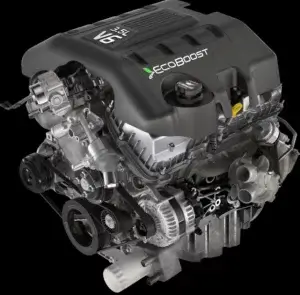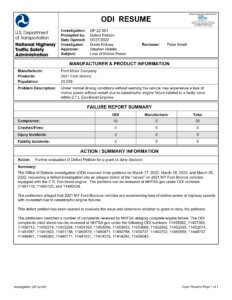Ford 2.7 EcoBoost Engine Problems
Ford 2.7 EcoBoost Engine Problems— a summary
The Fordd 2.7L EcoBoost engine is now in its 2nd generation. The first generation was used in these vehicles.
The original variant of the Ford 2.7 EcoBoost is found in the following models:
2015-2017 Ford F-150
2016-2018 Lincoln MKX
2017-2020 Lincoln Continental
2019-present Lincoln Nautilus
2015-2018 Ford Edge Sport
2019-present Ford Edge ST
2017-2019 Ford Fusion Sport
2nd Generation 2.7L EcoBoost Updates
Starting in 2018, certain models started to receive the 2nd generation EcoBoost engine. This version gets a boost to 400 torque. In addition Ford added port injection to wash the backs of the intake valves to reduce carbon buildup.
The 2nd generation engine also got a high pressure EGR system, lightweight cams, and electronically controlled turbo waste-gates. The 2nd gen Ford 2.7 EcoBoost is in the following cars:
2018-present Ford F-150
2021-present Ford Bronco
Ford 2.7 EcoBoost Engine Problem #1 — Poor quality valves causing total engine failure
The 1st generation 2.7 EcoBoost suffered from cheaper,
sub-optimal valves built by a new supplier that didn’t properly validate the quality of their components.
On May 27. 2022, the National Highway Traffic Safety Administration (NHTSA) opened a Federal Safety Investigation on the Ford 2.7 EcoBoost engine due to “Under normal driving conditions without warning the vehicle may experience a loss of motive power without restart due to catastrophic engine failure related to a faulty valve within 2.7 L Eco-Boost Engines.”
NHTSA states that 25,538 Broncos may have this problem
Ford 2.7 EcoBoost Engine problem #2 — Carbon Build-Up
Because direct injection shoots fuel direction into the cylinders, gas no longer washes the backside of intake valves. Since blowby is routed back into the intake to be burned in the cylinders, it hits the intakes valves on the way. Oil vapor deposits develop on the backsides of the intake valves and hardens into black buildup.
This buildup can eventually restrict air-flow and can cause 2.7L EcoBoost cylinders to receive inconsistent amounts of air. Carbon build-up can cause some drivability issues. It’s a serious enough problem that Ford had to add port injection to the Nano 2nd generation engine to cut down on carbon buildup.
Carbon Build-Up Symptoms
Symptoms of excess carbon deposits on the 2.7 EcoBoost intake valves include:
Misfires
Rough Idle
Stuttering / hesitation
Power loss
Carbon buildup problems show up first as misfires due to uneven air-flow into the cylinders. Next, you may notice the 2.7 EcoBoost idling rough or notice hesitation during acceleration. Power loss from carbon buildup can be fairly significant in some cases.
In the most severe cases, the deposits may be so bad that they prevent the intake valves from fully closing, resulting in compression.
Carbon Build-Up Fix
Walnut blasting requires the removal of the intake manifold and is the most effective way to remove the buildup. Walnut blasting the 2.7 EcoBoost engine usually runs bout $400-600. Expect to have your valves cleaned with walnut blasting every 70,000 to 100,000 miles on 1st generation Ford 2.7 EcoBoost engines.
Carbon buildup prevention
Oil breaks down over time and use and oil that’s been driven too long between changes causes more buildup problems than fresh oil. It deposits faster on intake valves and forms harden carbon. Changing oil on time is critical to engines with turbocharges.
CHANGE YOUR OIL ON TIME AND USE THE RECOMMENDED OIL TO REDUCE CARBON BUILDUP
Ford 2.7 EcoBoost Engine Problem #3 — Oil Pan Leaks
The oil pans on this engine are plastic. The plastic expands when hot and causes oil pan sealing issues and oil leaks. In 2018, Ford updated the pan design.
The poor oil pan design allows the oil pickup tube to become uncovered and suck in air, which in turn can destroy not only valves, but bearings as well, particularly during spirited or erratic driving when oil is sloshing around inside the engine.
Ford 2.7L V6 Oil Pan Leak Symptoms & Fix
Look for any visible oil leaks under the 2.7 EcoBoost engine. If you’re buying a used Ford vehicle with this engine, chances are the oil pan has already been replaced under warranty. But double check before you buy.
Ford 2.7 EcoBoost Engine Problem #4 — Spark Plugs & Ignition Coils
Turbochargers put extra stress on the ignition parts due to high cylinder pressures. On the 2.7L EcoBoost expect to replace spark plugs at around 40,000 to 60,000 miles. If you “tune” this engine expect to replace spark plugs every 10,000 miles.
Ford 2.7 EcoBoost Spark Plug & Ignition Coil Symptoms
Misfires
Rough idle
Stuttering / hesitation
Power loss
Check engine light (misfire codes)
Prevent ignition coil failures
Due to the high pressure and temperatures in turbo engines, the spark plug gaps can erode faster. When a spark plug gap erodes, it requires a higher firing voltage to fire. That adds stress to the ignition coil causing it to overheat. Overheated ignition coils fail early when overheated. You can prevent this by changing spark plugs at the earliest sign of failure.
©, 2022 Rick Muscoplat
Posted on by Rick Muscoplat
